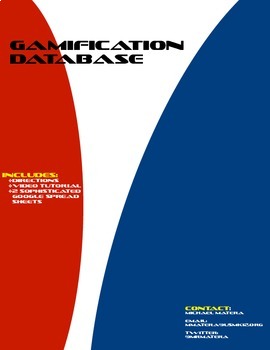
GRADING / TRACKING XP
Gamification Spreadsheet
This incredible Google spreadsheet by Mr. Matera is what I have used throughout the year. It enables you to enter and track XP along with the ability to display leaderboards for individuals, groups, and classes. It was also easy to embed different pages of the spreadsheet into our LMS.


I know of a few teachers who have used the 3D Gamelab platform as their classroom LMS with great success. Designed specifically with gamification in mind, this LMS has every feature that you would need in this type of learning environment.
BADGES & ACHIEVEMENTS

Class Badges gives educators the ability to customize and award badges to students based upon achievements, academic mastery, or even existing awards. I am not familiar with how well this integrates into other online environments, but its' recent partnership with EdStart leads me to believe that this tool has incredible potential moving forward.

Many educators who use Edmodo have most likely noticed the badge feature. If this is a platform that you currently use with your students, utilizing this makes sense since it is already built-in feature.
GOOGLE APPS
Even if you do not use an official badge app or LMS feature, you can of course develop your own badging system. For instance, this year I simply created a list of achievements for each scenario with a "badge" that was compiled into a Google Presentation and shared with the class.
CLASSROOM MANAGEMENT
Class Dojo is a customizable tool that helps provide feedback and reinforcements for positive classroom behaviors. There are also features to collect data and generate reports for parents and administrators.
As colleague (and awesome educator) Tim Downing states, "ClassCraft is like Class Dojo meets World of Warcraft." What makes this stand out is its emphasis on the role-playing and risk/reward system that plays out in the classroom.
Swiping In
"Swiping In" is a technique that I developed with colleague Brian Germain to help students (and us educators) monitor their progress in a mastery learning environment. Here is a post that describes the strategy in more detail as well as a quick video of student's demonstrating during class.
Mission Guides
These Google Documents help map out our gamified units. They include the type of mission, XP available, minimum XP to advance, assessments, and links to any resources and assignments needed.
Pacing
Of course, pacing is entirely up to the educator and how they would like to design their course. You can establish a more traditional, teacher-directed pace in which all students progress together, or you can completely open things up in an autonomous, self-paced learning environment. I have tried to find a middle ground, outlined below:
- Self-paced units, but we all start the next unit together.
- Each mission is graded, but those that students do not progress to ARE NOT given 0's.
- 50% of grade is based upon scored missions, other 50% based upon progress. (Based upon XP Scale)
If you know of any other resources to help manage a gamified classroom, please share below!
NEXT POST: RESULTS
Complete Gamification Series



No comments:
Post a Comment